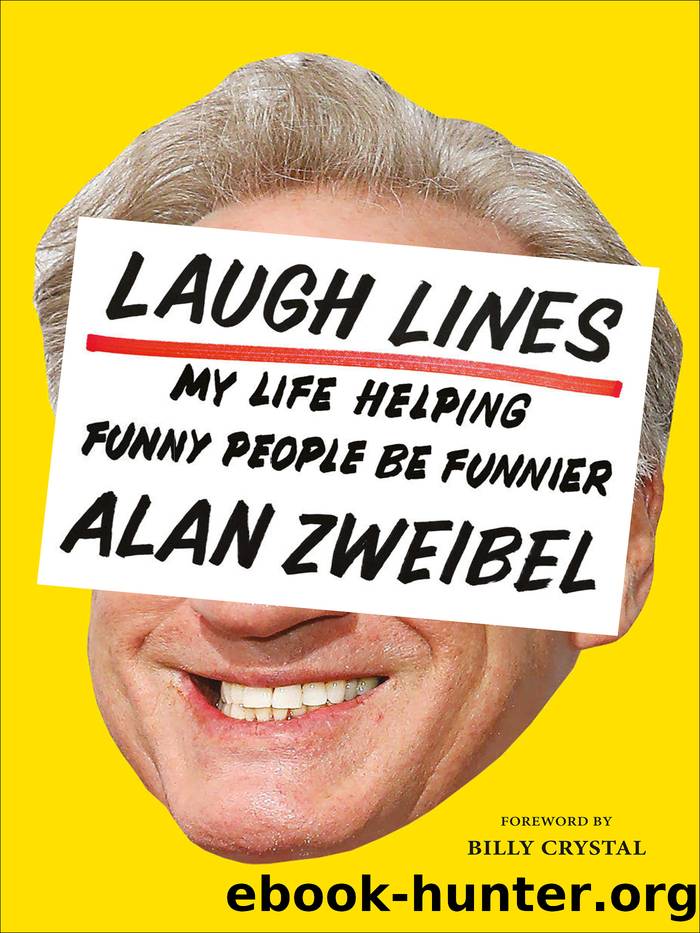Laugh Lines by Alan Zweibel

Author:Alan Zweibel
Language: eng
Format: epub
Publisher: Abrams
Published: 2020-04-14T00:00:00+00:00
In the mid-1980s, cable television was still relatively virgin territory for original comedy programming and a likely home for what we wanted to do. In this case, the word “likely” is a euphemism for “last resort.” In 1986 shows like Cheers, Perfect Strangers, The Cosby Show, and Who’s The Boss dominated the networks, but just as late-night was the perfect off-center place for SNL, what was then regarded as “experimental” found a welcome home on cable.
In fact, before Garry and I joined forces, he, Brad, and Bernie had pitched this idea to Brandon Tartikoff at NBC. I knew and admired Brandon. He was incredibly smart and funny and was unafraid of expanding what were then the parameters of television comedy. I’d first met Brandon when he was part of Fred Silverman’s regime my last year at SNL and then again in 1983, when Brandon himself was president of the network and I wrote an ill-fated pilot titled “Big Shots in America,” which was produced by Lorne, starred Joe Mantegna and Christine Baranski, and was directed by the great James Burrows. An awful lot of talent. Yet the biggest laugh, as I recall the experience, came at the rather dismal read-through, when, despite my pulling an all-nighter in my Brill Building office, a siren could be heard from outside, and Jim Burrows said, “It’s the comedy police,” and then Lorne whispered back, “They’re coming for the script.”
The “Big Shots in America” pilot was shot in front of a live audience and then shown to a test audience, who was less than enthused. And apparently Brandon was as well. Not that low test scores were necessarily the end-all to Brandon. The man was a true visionary who had the temerity to disregard low ratings, go with his gut, and stand behind initially struggling shows like Cheers and, later on, Seinfeld (which tested horribly) because he believed in them and put his faith in their creative teams. He gave those series the opportunity to grow with hopes that audiences would ultimately find and embrace them, and they did.
That said, his suggestions for what would have to be changed for him to even consider buying Garry’s idea are horrifying in retrospect. He didn’t want Garry to use his real name. He said Garry should play a character with another name. He didn’t think the audience could relate to or care about the life of a comedian and, instead, suggested that Garry’s character be a baby photographer. And Brandon further recommended that Garry not talk to the camera but to his dog. For those of you who think you may have misread those sentences, fret not. Brandon wanted Garry to play a baby photographer who confided in and shared his innermost feelings with his dog.
After Michael Fuchs, then the president of HBO, also passed on the show, it found a comfortable and excited home at Showtime, where its president, Peter Chernin, along with Allen Sabinson and Gary Keeper, encouraged us to present them our vision with promises of support.
Download
This site does not store any files on its server. We only index and link to content provided by other sites. Please contact the content providers to delete copyright contents if any and email us, we'll remove relevant links or contents immediately.
| Actors & Entertainers | Artists, Architects & Photographers |
| Authors | Composers & Musicians |
| Dancers | Movie Directors |
| Television Performers | Theatre |
Cecilia; Or, Memoirs of an Heiress — Volume 3 by Fanny Burney(30928)
Cecilia; Or, Memoirs of an Heiress — Volume 2 by Fanny Burney(30885)
Fanny Burney by Claire Harman(25778)
We're Going to Need More Wine by Gabrielle Union(18066)
Plagued by Fire by Paul Hendrickson(16630)
Cat's cradle by Kurt Vonnegut(13856)
Bombshells: Glamour Girls of a Lifetime by Sullivan Steve(13101)
All the Missing Girls by Megan Miranda(12740)
Leonardo da Vinci by Walter Isaacson(11896)
4 3 2 1: A Novel by Paul Auster(11034)
Adultolescence by Gabbie Hanna(8137)
The remains of the day by Kazuo Ishiguro(7542)
Note to Self by Connor Franta(7022)
Diary of a Player by Brad Paisley(6864)
Giovanni's Room by James Baldwin(5872)
What Does This Button Do? by Bruce Dickinson(5521)
Recovery by Russell Brand(4559)
Born a Crime by Trevor Noah(4507)
The Kite Runner by Khaled Hosseini(4416)
